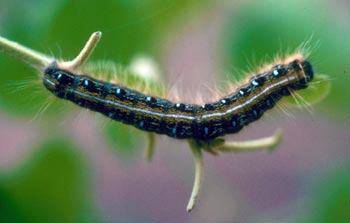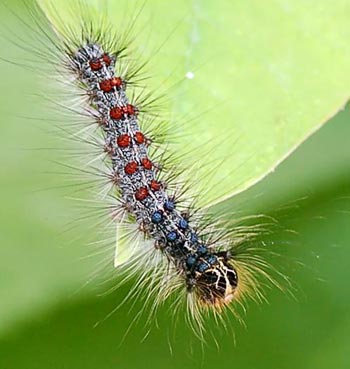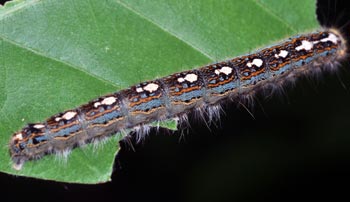What is eating my leaves? Spring leaf-eaters gardeners should know
Eastern tent caterpillars, gypsy moths and forest tent caterpillars are three spring leaf-eaters that could be damaging new foliage.
When new tree leaves are chewed up or completely eaten in the spring, gardeners become worried. Are these larvae or caterpillars going to be here all growing season? Will they kill my tree? These questions get answered by Michigan State University Extension horticulture educators and hotlines each spring. The good news is that you may not have a problem or missing leaves most years, but on occasion, your landscape or woodland trees may play host to one of these common pests. These three are ones you might encounter:
- Eastern tent caterpillars
- Gypsy moths
- Forest tent caterpillars
Smart gardeners will be looking for several things. Recognizing that leaves are being eaten is the first step. Leaves will have ragged holes on the edges of the leaf or next to the mid-vein. Caterpillars do not eat veins because those are tough. Leaves that have been fed on for a period of time may look like lace with veins exposed and leaf tissue stripped away. Each type of larvae is only feeding for approximately five to six weeks.
The second step is to look for the presence or absence of webbing in the tree. One of these three caterpillars creates a web. Use the identification information below to be sure which leaf-eater is your pest.
The third step is to make a decision if this requires the use of a pesticide or manual removal of the larvae. If the tree is 50 percent or more defoliated, it is a stress for the tree. If damage is light and is not increasing, it is not necessary to do anything. There are several pesticides that might be used, but if the larvae are small, insecticidal soap is a possibility or Bacillus thuringiensis, a naturally occurring soil bacterium, can be sprayed.
These three larvae or caterpillars all mature into moths and are relatively common to Michigan.
Eastern tent caterpillar
Scientific name: Malacosoma americanum
Time seen: April and May
Appearance: The body is black and has a white stripe down its back. Yellow and brown lines are on the sides. There are a row of oval blue spots on each side of the body. The head is black and the long, thin hairs on the body are yellow-orange.
Feeds on: Cherries, plums, peaches, hawthorns, apples and crabapples, later wandering to other trees and shrubs. They feed as a group or colony.
Web: Newly hatched larvae build a white, silky tent that webs wood-to-wood. The web is located where two branches come together in the crotch of the tree. Young are inside the tent when not feeding.
Control: Push a stick into the web and pull the web and larvae out of the tree. Drop them into a bucket of soapy water to “marinate” for the day. Spraying is ineffective when they are inside the web because the web repels the droplets. Often, they do not do a great deal of damage.
This is a native insect with many predators.
Gypsy moth
Scientific name: Lymantria dispar
Time seen: May and June
Appearance: Its appearance changes through its growth stages. This larva has long, silky hairs throughout its life as a juvenile. When tiny, the larva appears brown with stripes running the length of the body. As it grows larger, a series of paired blue or red raised dots appear along the back on the midline. The blue dots are closest to the head, followed by the red dots. There are also two raised bumps on each side of the head that look like earmuffs. There are ivory-colored markings on the face. Long hairs cover the body in tufts.
Feeds on: Oak, poplar, willow and many other species of trees. The larvae also feed on spruce and pine, especially when under or near deciduous trees. When newly hatched, they feed as a colony, but later disperse.
Web: There is no webbing.
Control: Insecticidal soap or Bt products are to be sprayed on leaves for the caterpillars to eat.
This is an alien insect from Europe. It has few predators and two diseases that offer some control.
Forest tent caterpillar
Scientific name: Malacosoma disstria
Time seen: April to May, possibly as late as June
Appearance: This caterpillar has a grayish-brown body with faint yellow and blue stripes running the length of the body. The blue stripes make the sides appear bluish. There are irregular white spots down the center of the back that resemble foot prints or keyhole shapes. The body has long, silky hairs.
Feeds on: Oak, aspen, sugar maple and many other deciduous trees. The caterpillars feed as a colony until they leave the trees to pupate.
Web: Does not construct a web. Instead, forest tent caterpillars create a silken mat or sheet on the bark of the tree. They use this area when molting to a larger size.
Control: Push a stick into the silken mat or sheet and pull the mat and larvae out of the tree. Drop them into a bucket of soapy water to “marinate” for the day. Spraying is ineffective when they are inside the silken mat or sheet because the mat repels the droplets. Often, they do not do a great deal of damage.
This is a native insect with many predators.
Photo credits: Eastern tent caterpillar – Tim Tigner, Virginia Department of Forestry, Bugwood.org; Gypsy moth – Jon Yuschock, Bugwoord.org; Forest tent caterpillar – William M. Ciesla, Forest Health Management International, Bugwood.org



 Print
Print Email
Email


